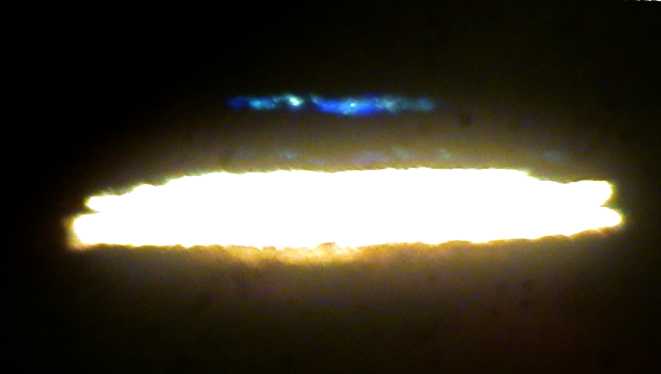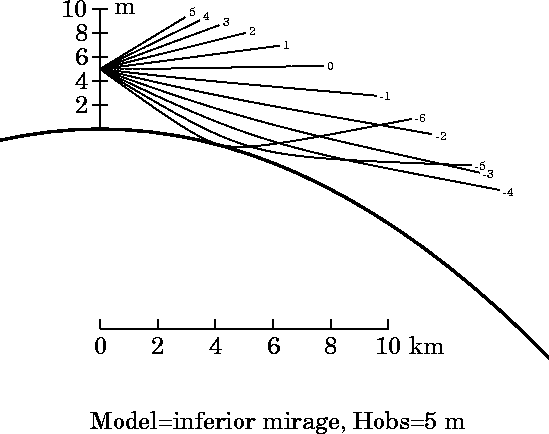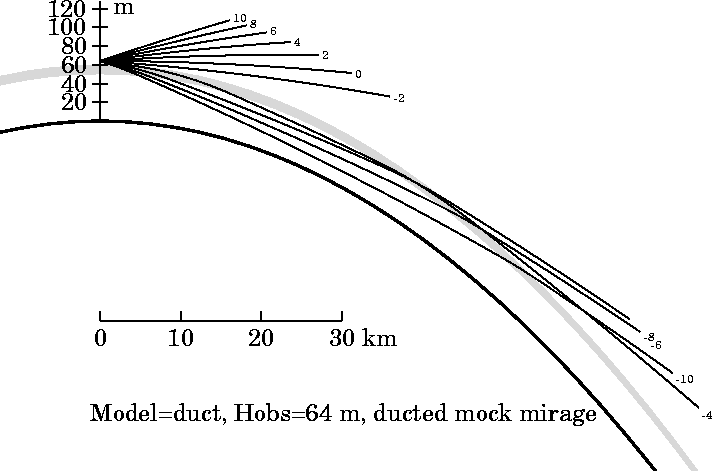
Fig 1. The green flash (rather blue actually) over the South Pole on 21 March 2000. (photo courtesy of Rodney Marks). This picture was taken with a digital camera through a Celestron C5 telescope.
|
B. Geerts |
4/'00 |
Just before sunrise or sunset some faint green (or aquamarine) light may be seen just above the solar disk (Fig 1). Green flashes have long been observed, possibly by the Ancient Egyptians, and they have been described and acribed by many famous people, including Alexander von Humboldt (who traveled extensively in the New World), Jules Verne (who wrote quite realistically about futuristic voyages), and Alfred Wegener (who introduced continental drift) (Wegener 1918).

Fig
1. The green flash (rather blue actually) over the South Pole on
21 March 2000. (photo courtesy of Rodney
Marks). This picture was taken with a digital camera through a
Celestron C5 telescope.
(1) The classic theory for a green flash is that scattering of sunlight by atmospheric gases causes a green image lying slightly above the red image of the Sun at the horizon. Raleigh scattering is most intense for the shortest wavelengths (blue and violet), causing red sunsets. Next the orange is absorbed by water vapor and ozone; so little more than red and green is left. Thus, the red Sun sets first, leaving the green image for a second or so. Unfortunately, quantitative calculations show that the green rim produced this way is too thin and faint to be visible to the naked eye (Dietze 1955)- as can be seen in Fig 2 (left). Also, most real green flashes appear not as a thin rim but as a separate flash, some distance above the solar disk, not on it. While this green-rim isolation is visible in binoculars or low-power telescopes, it is not the cause of any green flash worthy of the name.
|
|
|
|
|---|
Fig 2. Sunset in various lapse rate conditions (source: A.T. Young)
(left) A ICAO standard atmosphere is assumed (dT/dz = -6.5 K/km). The apparent flattening of the Sun is due to the refraction of the sunrays through the Earth's atmosphere, which is most dense near the ground
(middle) A standard atmosphere is assumed, except for a superadiabatic lapse rate in the lowest 2 m above the surface. The observer is at 5 m.
(right). A standard atmosphere is assumed, except for a weak inversion between 20 and 25 m above the ground; the observer is at 45 m.
(2) Most green flashes are actually inferior mirages (Fig 2, middle). An inferior mirage shows an upside-down image of the real object and is due to the 'reflection' of light on a thin layer of warmer (i.e. less dense) air near the ground or ocean surface. Inferior mirages are common in the desert or on a road heated by the Sun. Grazing rays bend back up into the denser air above (Fig 3). First, there's the reflection of the lower limb of the Sun that appears at the horizon. This is actually not a reflection in the ocean, but the miraged image of the part of the Sun a little higher up. During the first half of the sunset, this reflection joins the rest of the solar disk, first forming an omega shape (W), as described by Jules Verne.

Fig
3. Schematic depiction of Sun rays when an inferior mirage is
present. Hobs is the height of the observer. (source: A.T.
Young)
(3) Some green flashes may be caused by a mock mirage (Young et al 1997), caused by looking down through a thermal inversion, and then (thanks to the curvature of the Earth) back out through it again beyond the horizon (Fig 4). When the lower limb reaches the top of the inversion, it flattens out and pauses momentarily before popping back into view as a separate blob below the main disk, which it quickly joins (Fig 2, right). This blob is a double image of the lower limb. Notice the narrow, pointy indentations in the lower limb, just where the blob joins the disk above it. These indentations become pointy ``spikes'' sticking out of the upper limb when it reaches the altitude where the line of sight is just tangent to the 25-m top of the inversion layer. The pair of spikes separates from the rest of the Sun when they reach the top of the disk, accompanied by a weak green flash that is usually drowned out by the brighter disk below and "plume'' above. This plume turns green as it disappears, but its flash is weak, because it is so thin.

Fig
4. Schematic depiction of Sun rays when a mock mirage is present,
due to an inversion between 50-60 m. (source: A.T.
Young)
References
Dietze G., 1955: Die Sichtbarkeit des "grünen Strahls'', Zeitschrift fur Meteorologie 9, 169-178.
Wegener A., 1918: Elementare Theorie der atmosphärischen Spiegelungen. Annalen der Physik, 57, 203-230.
Young, A.T., G. W. Kattawar, and P. Parviainen 1997: Sunset Science. Part I. The Mock Mirage''. Appl. Opt., 36, 2689-2700. (also visit Dr. Young's website)